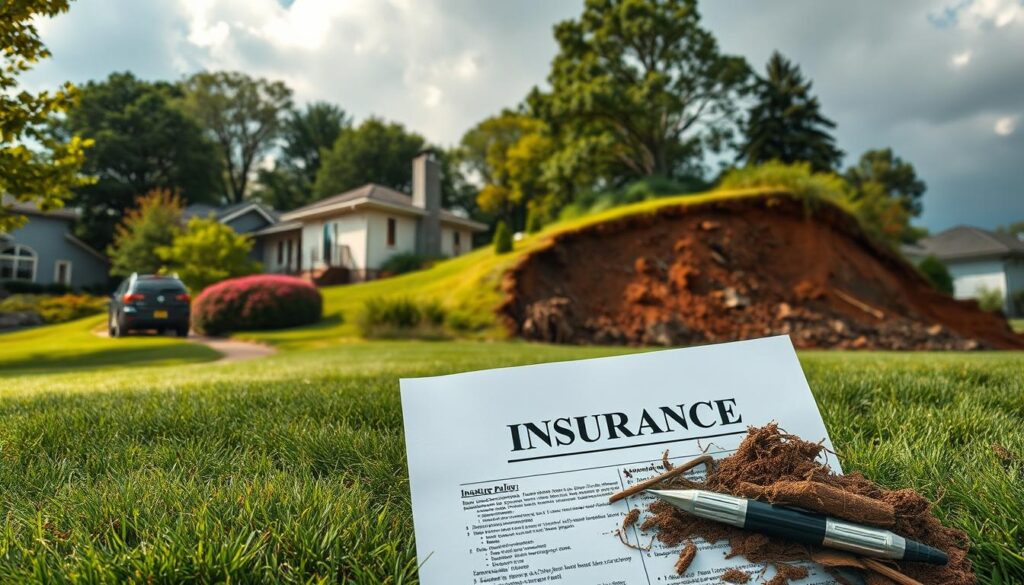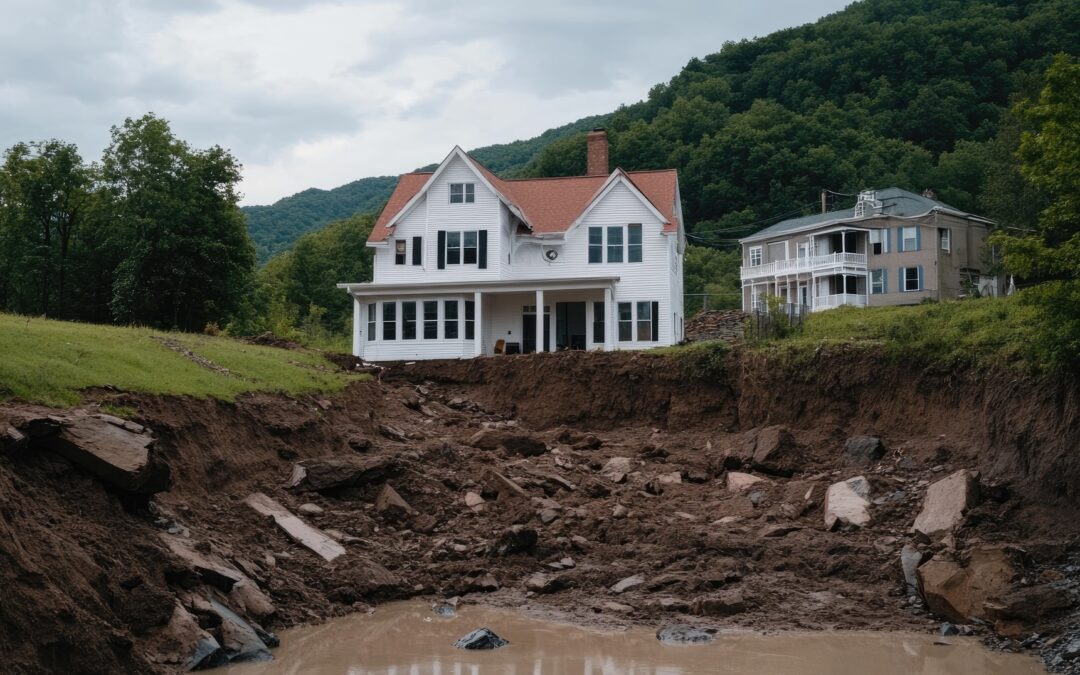If you live in an area that’s prone to natural disasters, you might wonder: does homeowners insurance cover mudslides? It’s key to know what your insurance covers and what it doesn’t. This knowledge helps protect your financial well-being. In this article, we’ll explore mudslide insurance claims and what your policy might cover.
Whether you’re new to homeownership or have been there for years, understanding your insurance is crucial. We’ll look at what your policy covers and what it doesn’t. Our goal is to give you a clear picture of your financial protection against mudslides. Join us as we dive into the details of homeowners insurance and natural disaster coverage. We’ll help you prepare for and handle these severe events.
Understanding Mudslide Coverage in Homeowners Insurance

We explore the key points of mudslide insurance in this section. It’s important for homeowners to understand these details. Knowing the difference between mudslides and other disasters helps ensure the right protection.
What is a Mudslide?
A mudslide, or debris flow, is a fast-moving mass of earth, water, and debris down a slope. They happen due to heavy rain, quick snowmelt, or land changes like deforestation. It’s vital for homeowners to know what causes mudslides to protect their homes.
How Mudslides Are Different from Landslides
Mudslides and landslides may look similar, but they’re not the same. Landslides are the movement of rock and soil, which can be slow or fast. Mudslides, on the other hand, are a flow of wet debris. Knowing these differences helps homeowners understand their insurance needs better.
Standard Homeowners Insurance Policy Basics
Standard homeowners insurance covers fires, windstorms, hail, and theft. But it doesn’t cover natural disasters like earthquakes, floods, or mudslides. Homeowners need extra policies or endorsements for mudslide protection. Knowing what a standard policy doesn’t cover helps homeowners make smart choices to protect their homes.
| Event Type | Coverage in Standard Policy | Additional Coverage Needed |
|---|---|---|
| Fire | Included | No |
| Windstorm | Included | No |
| Hail | Included | No |
| Theft | Included | No |
| Mudslide | Not Included | Yes |
Understanding mudslide insurance is crucial as natural disasters increase. To get the best protection, homeowners should do their research and adjust their policies accordingly.
Are Mudslides Included in Home Insurance Policies?
Knowing if mudslides are included in home insurance can save you from big financial surprises. Many people think their insurance covers all natural disasters. But, this isn’t always true.
Common Exclusions in Homeowners Insurance
It’s key to know what your homeowners insurance coverage details exclude. Most policies don’t cover floods, earthquakes, or mudslides. This is because these disasters can cause a lot of damage.
To check what your policy covers, read it carefully. Also, talk to your insurance company.
Policy Riders and Endorsements for Mudslide Coverage
Since standard policies often don’t cover mudslides, many look into policy riders and endorsements. These can help protect you from damage not covered by basic policies. It’s important to understand what these riders include.
For more info, insurance experts can offer great advice. They can help you decide if adding riders is right for you.
So, are mudslides included in home insurance? Usually, no. But, getting policy riders can fill this gap.
By talking to experts, carefully reviewing your policy, and choosing the right endorsements, you can get the right coverage. Knowing what’s excluded and what’s available helps you protect your home from mudslides.
Does Homeowners Insurance Cover Mudslides?
Many people wonder, does homeowners insurance cover mudslides? After looking into policy details and industry rules, we have a clear answer. Standard homeowners insurance usually doesn’t cover mudslide damage. This is because mudslides are seen as earth movements, like earthquakes and landslides, which are often not covered.
If you want mudslide coverage, you need to look into extra policy options. The most common way to get this is through a Difference in Conditions (DIC) policy. This policy fills in gaps not covered by standard insurance, including mudslides. DIC policies also cover floods, earthquakes, and more, offering more protection.
ValuePenguin says homeowners must buy special policies from certain providers to protect against these disasters. Knowing what these policies cover is key to making a smart choice.
Here’s a comparison of standard and DIC policy coverages:
| Coverage Type | Standard Homeowners Insurance | DIC Policy |
|---|---|---|
| Fire | Included | Included |
| Theft | Included | Included |
| Earthquake | Excluded | Included |
| Flood | Excluded | Included |
| Mudslide | Excluded | Included |
To sum up, standard homeowners insurance doesn’t cover mudslides. But, there are special policies like DIC that do. By looking into these options and understanding what they cover, homeowners can protect their homes from mudslide damage.
Mudslide Damage and Insurance Claims
Homeowners dealing with mudslide damage need to know how to file successful insurance claims. It’s important to document damage well and follow the right steps. This guide will help you through the process.
Documenting Mudslide Damage
Start by documenting the damage. Take photos and videos of the damage inside and outside your home. Also, get professional opinions from engineers or disaster recovery experts. This helps show the full extent of the damage.
Filing a Mudslide Insurance Claim
Filing a claim involves several steps. First, call your insurance company to report the damage. They will tell you what information and forms you need. Then, list all damaged items and their costs.
Keep in touch with your claim adjuster. For more help, consider talking to an expert. Companies like Grun Law Corporation help with complex claims after disasters.
Tips for a Successful Claim
To increase your chances of a successful claim, follow these tips:
| Tips | Description |
|---|---|
| Proper Documentation | Keep thorough records of all damage, including photos, videos, and professional assessments. |
| Timely Reporting | Report the mudslide damage to your insurer as soon as possible to initiate the claim process. |
| Expert Consultation | Engage experts like engineers or claim specialists to support your claim with authoritative reports. |
| Detailed Inventory | Provide an extensive list of damaged belongings with associated costs and proof of ownership or value. |
By following these tips, you can improve your chances of getting the insurance settlement you need. This will help you recover and rebuild your home.
Protecting Your Home from Mudslide Risks
In our final section, we focus on how to protect your home from mudslides. Mudslide prevention is key for homeowners in high-risk areas. By using smart construction and landscaping, we can make our homes safer from mudslides.
First, think about the materials and methods used in building your home. Reinforced foundations and walls help homes on slopes stay stable. Steel or concrete is best for these jobs to fight against ground shifts. Also, good drainage systems are crucial to manage water and prevent soil from getting too wet.
Landscaping can also help prevent mudslides. Plants with deep roots hold the soil together and stop erosion. Creating terraces and water channels to move water away from your home are smart moves. Working with landscape experts can help find the best solutions for your area.
Finally, using community and government resources can help a lot. There are grants for projects that make homes safer from mudslides. Joining local groups and following environmental rules can keep you ready and active. By taking these steps, we not only protect our homes but also make our communities safer and stronger.
Consult with Grun Law Corporation
If your property is damaged by a mudslide, Grun Law Corporation offers a free consultation to help you understand your legal options. With deep experience in California property damage law, their team can guide you through the process, from handling damage assessment reports to securing compensation.
Don’t navigate a mudslide damage case alone. Call Grun Law Corporation at (818) 433-7742 for expert advice that protects your rights and prioritizes your interests.
FAQ
What is a Mudslide?
A mudslide is a fast-moving landslide. It’s made of water-soaked earth, soil, debris, and organic matter. Heavy rain, rapid snowmelt, or other factors can trigger it.
How are Mudslides Different from Landslides?
Mudslides and landslides are similar but different. Mudslides mix water with soil and debris, making them more fluid. Landslides can be rockfalls or slow-moving soil slumps.
Do Standard Homeowners Insurance Policies Cover Mudslides?
Most homeowners insurance doesn’t cover mudslides. They’re often seen as “earth movement,” which is excluded. But, coverage can vary. Always check your policy or talk to your insurance provider.
How Can I Get Mudslide Coverage?
To get mudslide coverage, you might need a “Difference in Conditions” (DIC) policy. Or, you can add endorsements or riders for earth movements. These can be found through specialized insurance providers.
What Are Common Exclusions in Homeowners Insurance?
Homeowners insurance often excludes natural disasters like mudslides, earthquakes, floods, and sinkholes. This highlights the need for extra coverage for full protection.
What Should I Document When Making a Mudslide Insurance Claim?
Documenting mudslide damage is crucial. Take photos of the damage, list what’s broken, get professional opinions, and save receipts and repair estimates.
How Do I File a Mudslide Insurance Claim?
To file a claim, first tell your insurance provider about the damage. Follow their steps for submitting your documents. Make sure to meet deadlines and keep records of all talks.
What Tips Can Help Ensure a Successful Mudslide Insurance Claim?
Document damage well, file your claim quickly, keep detailed records, and consider professional help. Clear communication and thorough documentation are key.
How Can I Protect My Home from Mudslide Risks?
To protect your home, maintain drainage systems, stabilize slopes with plants, and build retaining walls. Follow local building codes in mudslide-prone areas. Community resources and government grants can also help with prevention.

